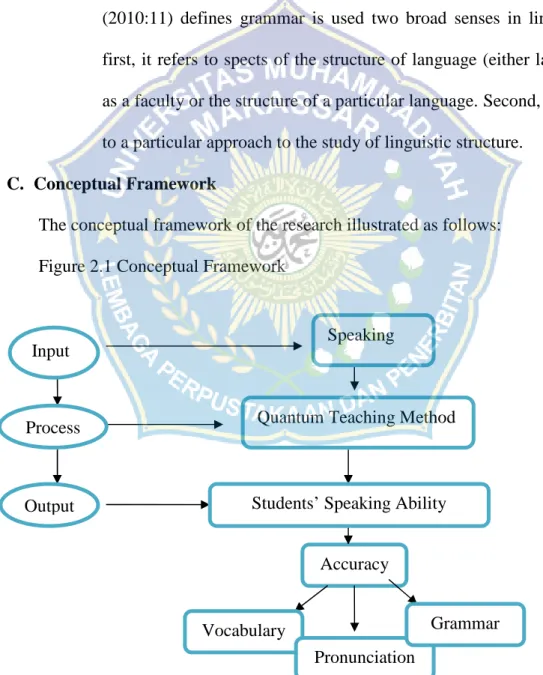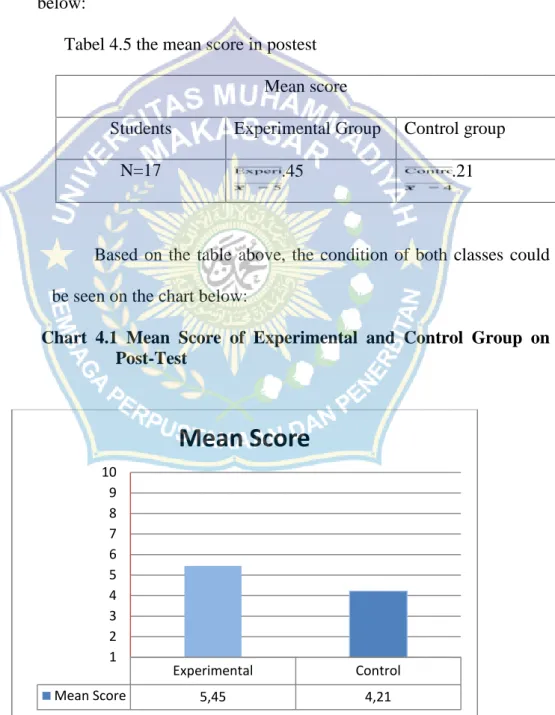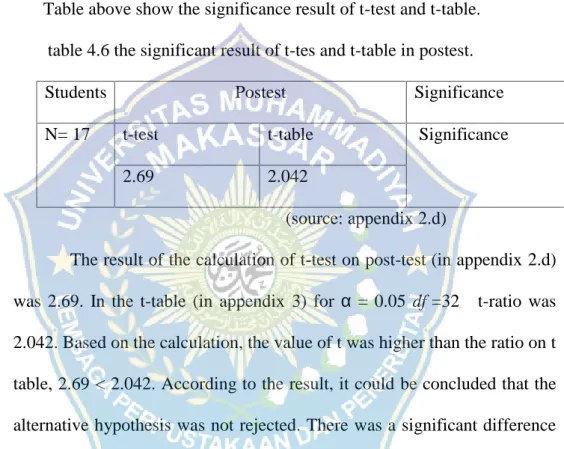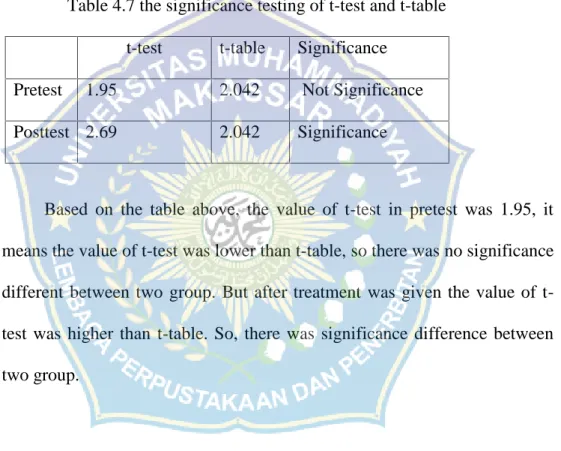INTRODUCTION
Background
Problem Statement
Objectives of the Study
Significance of the Study
Scope of the Study
LITERATURE REVIEW
Quantum Teaching
- The definition of QuantumTeaching Method
- The foundation of Quantum Teaching Method
- The aims of Quantum Teaching Method
- The Principle and model QTM
- The model of Quantum Teaching Method
- The framework of QTM
The teacher gave some information about the subject, for example: .. the importance of self-presentation. f. The teacher asked the students some questions in order to ... get to know the students. understanding of the material. me. The average vocabulary score of students in the pretest for the experimental group was 4.80. the result of the average vocabulary score of students in the control group was 4.71.
The result of the students' grammar in the pretest showed that the average score for the students' grammar in the experimental group was 4.21. The result of the students' pronunciation in the posttest, which showed that the average score of the students' vocabulary in the experimental group was 6.28. The result of the students' grammar in the posttest, which showed that the average score for the students' grammar in the experimental group was 5.49.
Hasanuddin, R.2015. The Motivation of Eleventh Grade Network and Computer Program Students at SMK NEGERI 1 Watampone in Vocabulary Learning Using Humor, (Offline), (http://myedu20.blogspot.com/, di akses 4 June 2015). ). 2008. The effect of a communication approach on the speaking ability of students for the initial level of the 1st year of MT.
Concept Of Speaking
- Speaking Ability
- The characteristics of successful Speaking Ability
- Assessing Speaking ability
Conceptual Framework
PROCESS: To improve all of them, there is a method of teaching speaking skills that will be applied in this study. OUTPUT: Refers to improving students' speaking skills, students can speak English well and fluently.
Hypothesis
RESEARCH METHODOLOGY
- Research Design
- Population and Sample
- Variable and Indicator
- Instrument of Study
- Procedure of Data Collection
- Technique of Data Analysis
Before the treatment was given, the students' fluency in word accuracy was very low (categorized as very poor). First step: the teacher will motivate the students to make the students interested in English. The teacher gives the students experience about the material they are going to learn: the teacher gives experience.
Second step: the teacher gives the students experience with the material that the students encountered in their daily lives. In the fourth step, students can demonstrate their ability to make announcements and answer the question about announcements: Second step: The teacher gives students experience with the material students encountered in their daily lives.
Last step, if the students can explain the material, the teacher will give them something valued as a gift. Fourth step gives students change to demonstrate their ability to make something based on procedure.
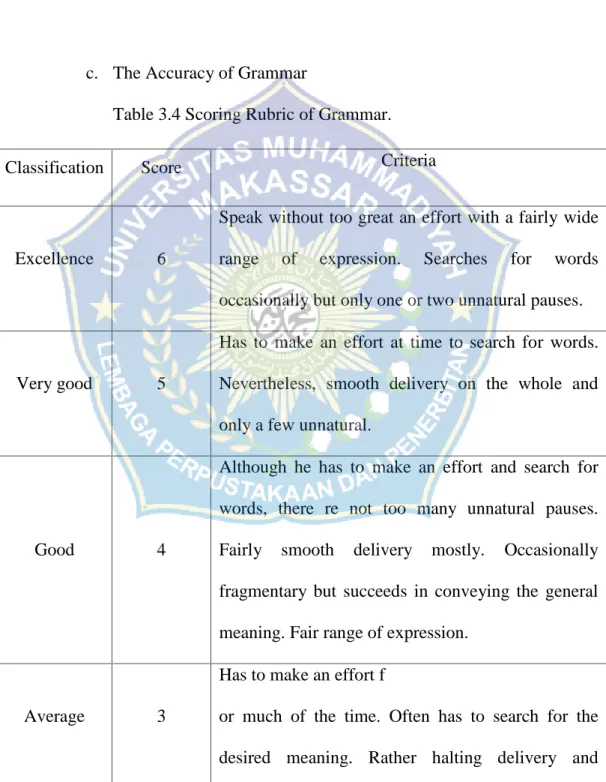
RESEARCH FINDINGS AND DISCUSSION
Finding
The pre-test aimed to discover the equality of the two groups before administering treatments using the t-test procedure. The table below will describe the result of students speaking accurately in pre-test for experimental group and control group. The result of students' pronunciation in pre-test showed that the mean score of students' pronunciation in experimental group was 4.71.
The result of the students' average accuracy score in the pretest was from the total accuracy of the students' scores that were administered. The mean score in the experimental group was 4.58, and the mean score in the control group was 4.15. Based on the table above, the mean score of the experimental group in the pretest was 4.58, and the mean score of the control group was 4.15.
It means that the mean score of experimental group was higher than the control group before the treatment was given. This result implied that the experimental group and the control group were similar in their initial ability. The result of the students' pronunciation in the posttest, which showed that the average score of the students' pronunciation in the experimental was 7.06.
The mean score of the students' speaking accuracy in the posttest was derived from the total accuracy score of the students who performed them. The mean score in the experimental group was 5.45, and the mean score in the control group was 4.21. Based on the table above, the t-test value in the pre-test was 1.95, which means that the t-test value was lower than the t-table, so there was no significance difference between the two groups.
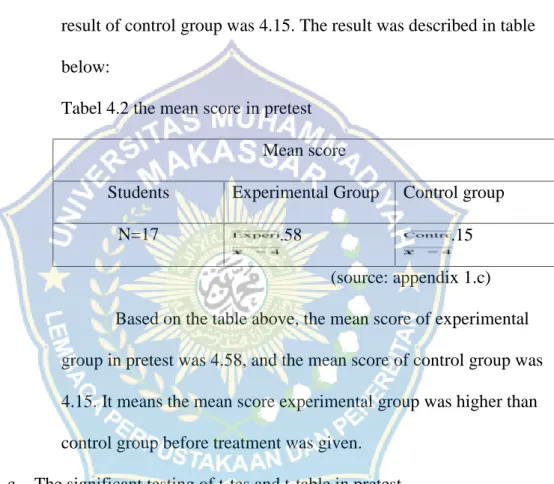
Discussions
The sum result of students' vocabulary in pretest for experimental group was 81.66, and the mean score was 4.80. And the sum result of students' grammar in pretest for experimental group was 71.64, and the mean score was 4.21. So, according to mean score of experimental and control group which calculated, the result of t-test was 1.95, and the result of t-table was 2.042 because df result was 32 students.
The sum result of the students' vocabulary in the pretest for the experimental group was 108.68, and the average score was 6.28, and the sum result in the control group was 81.66, and the average score was 4.8. So according to the average score of the experimental and control group who did the calculations, the t-test result was 2.69 and the t-table result was 2.042 because the df result was 32 students. Because the average score of the experimental group was increased, and the average result of the experimental group was permanently higher than the control group.
The teacher gives some questions to know the understanding of the students about material. identical to giving things, praise and appreciation. Last step, if the students can explain the material, the teacher will appreciate them with a gift something like us: candy. Fourth, teacher gives the students change to demonstrate their ability by answering the question, the question is: the students make dialogue based on example above.
The last step, if the students can explain the material, the teacher will give them to evaluate with a gift something like us: candy. The last step, if the students can explain the material, the teacher will give them to evaluate with a gift something like us: candy. The fourth step gives the students the opportunity to demonstrate their ability to dialogue using the expressive command and to answer the question about the expression of the command.
Step four gives students change to demonstrate their ability to create dialogue by providing information, and fill in the blank by providing information.
CONCLUSION AND SUGGESTIONS
Conclusion
The result of t-tes was lower than t-table, it means that there was no significance between two groups. The result of the posttest there was a significant difference after the treatment was carried out in the posttest. The result of t-test was higher than t-table, it means that there was significance between two groups after treatment was given.
In the pretest result, there was no significance between T-test and T-table, because the T-test value was lower than the t-table, it showed that the alternative hypothesis was rejected. And after the treatment was given, in the post test result, there was significance between T-test and T-table, because the value of t-test was higher than t-table, it showed that the alternative hypothesis was not rejected. So, this study has proven that the quantum teaching method was effective in improving students' speaking skills.
Suggestions
The teacher gives some information about the topic, for example: the importance of self-presentation. The third step, then the teacher gives the name, in this step the teacher gives the name of the material, the name of the material is introductory. The third step, after that the teacher makes the naming, in this step the teacher gives the naming of the material, the naming of the material is greeting.
The second step, the teacher gives experience about nature, for example: we can see our mother at home when they ask us to close the door, which is called instruction.
